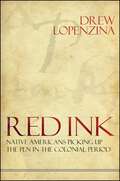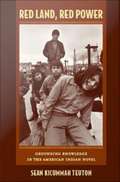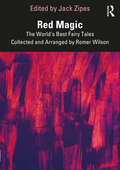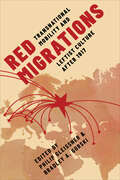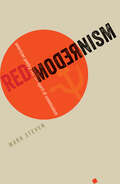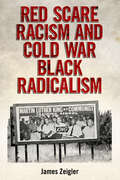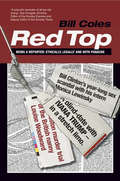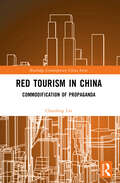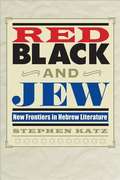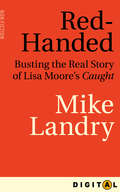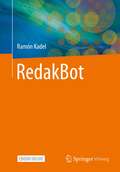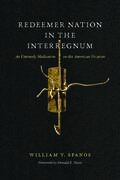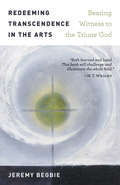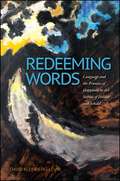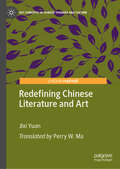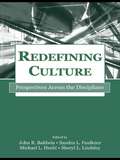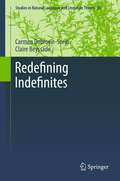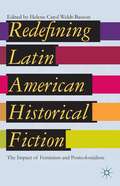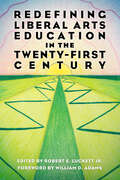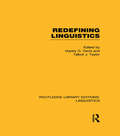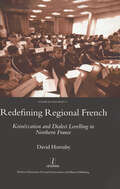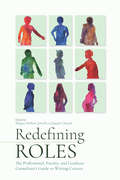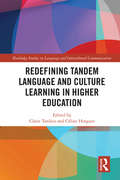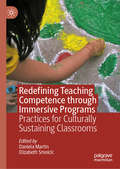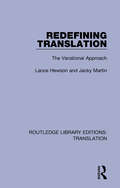- Table View
- List View
Red Ink: Native Americans Picking Up the Pen in the Colonial Period (SUNY series, Native Traces)
by Drew LopenzinaThe Native peoples of colonial New England were quick to grasp the practical functions of Western literacy. Their written literary output was composed to suit their own needs and expressed views often in resistance to the agendas of the European colonists they were confronted with. Red Ink is an engaging retelling of American colonial history, one that draws on documents that have received scant critical and scholarly attention to offer an important new interpretation grounded in indigenous contexts and perspectives. Author Drew Lopenzina reexamines a literature that has been compulsively "corrected" and overinscribed with the norms and expectations of the dominant culture, while simultaneously invoking the often violent tensions of "contact" and the processes of unwitnessing by which Native histories and accomplishments were effectively erased from the colonial record. In a compelling narrative arc, Lopenzina enables the reader to travel through a history that, however familiar, has never been fully appreciated or understood from a Native-centered perspective.
Red Land, Red Power: Grounding Knowledge In the American Indian Novel
by Sean Kicummah TeutonIn lucid narrative prose, Sean Kicummah Teuton studies the stirring literature of "Red Power," an era of Native American organizing that began in 1969 and expanded into the 1970s. Teuton challenges the claim that Red Power thinking relied on romantic longings for a pure Indigenous past and culture. He shows instead that the movement engaged historical memory and oral tradition to produce more enabling knowledge of American Indian lives and possibilities. Looking to the era's moments and literature, he develops an alternative, "tribal realist" critical perspective to allow for more nuanced analyses of Native writing. In this approach, "knowledge" is not the unattainable product of disinterested observation. Rather it is the achievement of communally mediated, self-reflexive work openly engaged with the world, and as such it is revisable. For this tribal realist position, Teuton enlarges the concepts of Indigenous identity and tribal experience as intertwined sources of insight into a shared world. While engaging a wide spectrum of Native American writing, Teuton focuses on three of the most canonized and, he contends, most misread novels of the era--N. Scott Momaday's House Made of Dawn (1968), James Welch's Winter in the Blood (1974), and Leslie Marmon Silko's Ceremony (1977). Through his readings, he demonstrates the utility of tribal realism as an interpretive framework to explain social transformations in Indian Country during the Red Power era and today. Such transformations, Teuton maintains, were forged through a process of political awakening that grew from Indians' rethought experience with tribal lands and oral traditions, the body and imprisonment, in literature and in life.
Red Magic: The World’s Best Fairy Tales Collected and Arranged by Romer Wilson
by Jack Zipes Kay NielsenWith a Preface and biographies from Jack Zipes, as well as the original illustrations by Kay Nielsen, this collection of fairy tales originally published by the award-winning Romer Wilson – Green Magic (1928), Silver Magic (1929), and Red Magic (1930) – offers a combination of classic fairy tales, alongside lesser known, global and diverse tales. Red Magic contains such classics as “Aladdin and the Wonderful Lamp” from the Arabian Nights, “A Child’s Dream on a Star” by Dickens, and “The Chimera” by Hawthorne. It also contains previously unpublished tales such as “Princess Silver Silk” and “The Enchanted Deer.” It was Romer Wilson’s intention to combine the familiar with the unknown, and to introduce authors and cultures from a variety of countries. As a researcher, Wilson uncovered a remarkable amount of stories from other countries that remain unknown today. This collection gives voice to unique and intriguing tales that inspire children to have a better understanding of how people and their stories are alike despite major differences. Through his Preface and commentary, Jack Zipes shows how all three books are a means to bring people together in the name of peace and justice. These books will, therefore, be of interest to anyone researching or studying fairy tales, folklore and children’s literature, as well as global or comparative literature and social justice.
Red Migrations: Transnational Mobility and Leftist Culture after 1917
by Philip Gleissner Bradley A. GorskiTogether with a new political, social, and cultural order, the Bolshevik Revolution also brought about a spatial revolution. Changed patterns, motivations, and impacts of migration collided with new cultural forms and aesthetic mandates. Red Migrations highlights the various multidirectional and multilateral transnational movements of leftist thinkers, artists, and writers. The book draws on avant-garde poets such as David Burliuk, Marxist theoreticians such as János Mácza, and “fellow travellers” such as Langston Hughes, revealing how leftists of all stripes were inspired and at times impelled by the Soviet Revolution to cross borders. It explores how the resulting circulation of ideas, aesthetic forms, and individuals not only contributed enormously to the ferment of creative activity in the early Soviet years, but also deeply informed international leftist aesthetics and political practice throughout the twentieth century. The robust and diverse transnational networks created by these circulations are at the centre of this volume. With original archival research and insightful analyses, Red Migrations sheds light on the ideals, aspirations, and disappointments of leftist transnationalism from the 1920s through the 1960s and the aesthetic forms they engendered.
Red Modernism: American Poetry and the Spirit of Communism (Hopkins Studies in Modernism)
by Mark StevenHow did modernist poetry respond—both thematically and technically—to communism?In Red Modernism, Mark Steven asserts that modernism was highly attuned—and aesthetically responsive—to the overall spirit of communism. He considers the maturation of American poetry as a longitudinal arc, one that roughly followed the rise of the USSR through the Russian Revolution and its subsequent descent into Stalinism, opening up a hitherto underexplored domain in the political history of avant-garde literature. In doing so, Steven amplifies the resonance among the universal idea of communism, the revolutionary socialist state, and the American modernist poem.Focusing on three of the most significant figures in modernist poetry—Ezra Pound, William Carlos Williams, and Louis Zukofsky—Steven provides a theoretical and historical introduction to modernism’s unique sense of communism while revealing how communist ideals and references were deeply embedded in modernist poetry. Moving between these poets and the work of T. S. Eliot, Langston Hughes, Muriel Rukeyser, Gertrude Stein, Wallace Stevens, and many others, the book combines a detailed analysis of technical devices and poetic values with a rich political and economic context. Persuasively charting a history of the avant-garde modernist poem in relation to communism, beginning in the 1910s and reaching into the 1940s, Red Modernism is an audacious examination of the twinned history of politics and poetry.
Red Scare Racism and Cold War Black Radicalism (Race, Rhetoric, and Media Series)
by James ZeiglerDuring the early years of the Cold War, racial segregation in the American South became an embarrassing liability to the international reputation of the United States. For America to present itself as a model of democracy in contrast to the Soviet Union's totalitarianism, Jim Crow needed to end. While the discourse of anticommunism added the leverage of national security to the moral claims of the civil rights movement, the proliferation of Red Scare rhetoric also imposed limits on the socioeconomic changes necessary for real equality. Describing the ways anticommunism impaired the struggle for civil rights, James Zeigler reconstructs how Red Scare rhetoric during the Cold War assisted the black freedom struggle's demands for equal rights but labeled “un-American” calls for reparations. To track the power of this volatile discourse, Zeigler investigates how radical black artists and intellectuals managed to answer anticommunism with critiques of Cold War culture. Stubbornly addressed to an American public schooled in Red Scare hyperbole, black radicalism insisted that antiracist politics require a leftist critique of capitalism. Zeigler examines publicity campaigns against Dr. Martin Luther King Jr.'s alleged Communist Party loyalties and the import of the Cold War in his oratory. He documents a Central Intelligence Agency-sponsored anthology of ex-Communist testimonials. He takes on the protest essays of Richard Wright and C. L. R. James, as well as Frank Marshall Davis's leftist journalism. The uncanny return of Red Scare invective in reaction to President Obama's election further substantiates anticommunism's lasting rhetorical power as Zeigler discusses conspiracy theories that claim Davis groomed President Obama to become a secret Communist. Long after playing a role in the demise of Jim Crow, the Cold War Red Scare still contributes to the persistence of racism in America.
Red Top: Being a Reporter - Ethically, Legally and with Panache
by Bill ColesRed Top has everything an aspiring reporter needs to know about newspaper journalism. Written in easily digestible bite-size chapters, the book is packed with extraordinary stories that explain what it's really like to be a front-line reporter. Included is a full breakdown on the two key skills of how to interview and how to dig up exclusives. Plus tips on dealing with the mad-masters, the editors; writing a news story; and what the hell to do when a libel writ comes thudding onto your desk.Bill Coles has been a journalist for 25 years and was The Sun's New York Correspondent, Political Correspondent and Royal Reporter. He has written for a huge variety of papers from The Wall Street Journal to the Mail, the Scotsman and Prima Baby Magazine.He has also covered some of the world's biggest news stories - as well as some of the most bizarre --Bill Clinton's year-long sex scandal with his intern Monica Lewinsky.-The Boston murder trial of the British nanny Louise Woodward (with five Sun front pages in a row).-Buying $10,000 of lottery tickets in Miami-A blind-date with Ivana Trump - in a stretch limo.-Becoming one of Company magazine's Bachelors of the Year.-Flying from New York to the Inca trail in Peru - to eat a giant guinea-pig.-Posing naked for a Sun centrefold - with nothing but a copy of The Sun to hide his modesty.
Red Tourism in China: Commodification of Propaganda (Routledge Contemporary China Series)
by Chunfeng LinThis book analyzes the phenomenally profitable “Red Tourism” industry in China, in which visitors make pilgrimages to sites of historical significance to the Communist Party of China and the Chinese Revolution. The book examines Red Tourism in connection with the transforming power relations between the state and the private, communication in the socialist past, and the current round of capitalization, against the backdrop of the world’s second largest economy. By re-evaluating the conventional notion of propaganda through the lens of neutral xuanchuan propaganda, the book presents a nuanced look at the social space of Red Tourism, revealing that propaganda should be conceived as a commodity, an industry, or even a media system similar to the news media. Drawn from combining fieldwork and cultural analysis spanning a decade, this book will be of interest to students and scholars of communication studies, tourism, and Chinese politics.
Red, Black, and Jew: New Frontiers in Hebrew Literature
by Stephen KatzBetween 1890 and 1924, more than two million Jewish immigrants landed on America's shores. The story of their integration into American society, as they traversed the difficult path between assimilation and retention of a unique cultural identity, is recorded in many works by American Hebrew writers. Red, Black, and Jew illuminates a unique and often overlooked aspect of these literary achievements, charting the ways in which the Native American and African American creative cultures served as a model for works produced within the minority Jewish community. Exploring the paradox of Hebrew literature in the United States, in which separateness, and engagement and acculturation, are equally strong impulses, Stephen Katz presents voluminous examples of a process that could ultimately be considered Americanization. Key components of this process, Katz argues, were poems and works of prose fiction written in a way that evoked Native American forms or African American folk songs and hymns. Such Hebrew writings presented America as a unified society that could assimilate all foreign cultures. At no other time in the history of Jews in diaspora have Hebrew writers considered the fate of other minorities to such a degree. Katz also explores the impact of the creation of the state of Israel on this process, a transformation that led to ambivalence in American Hebrew literature as writers were given a choice between two worlds. Reexamining long-neglected writers across a wide spectrum, Red, Black, and Jew celebrates an important chapter in the history of Hebrew belles lettres.
Red-Handed: Busting the Real Story of Lisa Moore's Caught
by Mike LandryThe true stories that inspired Lisa Moore’s latest novel Caught. When journalist Mike Landry called Lisa Moore for an interview, he began by listing four names, and asking, “What do these names mean to you?” The award-winning author of Alligator and February paused and took a deep breath. Not one of the names appears in Caught, but their stories were more entwined with Moore’s fictional account of Newfoundland drug-running in the 1970s than even the author knew. In this profile of Moore, fate, fortune, freedom and the little town of Ferryland, Newfoundland, come together to form a picture of Canada’s greatest writer at the peak of her form. Originally published in Salon, New Brunswick’s home for fine art and culture in the Telegraph-Journal, Anansi Digital offers Red-Handed for the first time to a national audience.
RedakBot
by Ramón KadelDer Journalismus ist im Wandel – nicht nur aufgrund des Medienstrukturwandels durch Digitalisierung und Internet, sondern auch aufgrund neuer Technologien, die erstmals sogar ein Stück weit die Existenzberechtigung des Berufsbilds infrage stellen. Werden Journalisten also durch künstliche Intelligenz ersetzt? Nein! Denn KI im Journalismus ist ein „Frenemy“: Freund und Feind zugleich. Freund, wenn man sich auf den KI-Journalismus vorbereitet, Feind für diejenigen, die ihr Mindset nicht ändern können und die neuen Technologien ausschließlich als Bedrohung sehen. Mit der Lektüre dieses Buches sollen Journalisten und Redakteure sowie Volontäre und Studenten im Bereich der Kommunikationswissenschaften konkrete Ideen im Kopf haben, wie sie sich auf die Zeit des KI-Journalismus erfolgreich vorbereiten. Es regt an, innovativ zu sein, und von den neuen Möglichkeiten, die redaktionelle Bots bieten, zu partizipieren – und schließlich zu profitieren. Die Frage ist nicht, ob „RedakBots“ unsere Arbeitswelt verändern, sondern wann dies passiert. Das Buch bereitet darauf vor.
Redeemer Nation in the Interregnum: An Untimely Meditation on the American Vocation
by William V. SpanosRedeemer Nation in the Interregnum interrogates the polyvalent role that American exceptionalism continues to play after 9/11. Whereas American exceptionalism is often construed as a discredited Cold War–era belief structure, Spanos persuasively demonstrates how it operationalizes an apparatus of biopolitical capture that saturates the American body politic down to its capillaries.The exceptionalism that Redeemer Nation in the Interregnum renders starkly visible is not a corrigible ideological screen. It is a deeply structured ethos that functions simultaneously on ontological, moral, economic, racial, gendered, and political registers as the American Calling. Precisely by refusing to answer the American Calling, by rendering inoperative (in Agamben’s sense) its covenantal summons, Spanos enables us to imagine an alternative America.At once timely and personal, Spanos’s meditation acknowledges the priority of being. He emphasizes the dignity not simply of humanity but of all phenomena on the continuum of being, “the groundless ground of any political formation that would claim the name of democracy.”
Redeeming Transcendence in the Arts: Bearing Witness to the Triune God
by Jeremy BegbieHow can the arts witness to the transcendence of the Christian God? Many people believe that there is something transcendent about the arts, that they can awaken a profound sense of awe, wonder, and mystery, of something &“beyond&” this world—even for those who may have no use for conventional forms of Christianity. In this book Jeremy Begbie—a leading voice on theology and the arts—employs a biblical, Trinitarian imagination to show how Christian involvement in the arts can be shaped by the distinctive vision of God&’s transcendence opened up in and through Jesus Christ.
Redeeming Words: Language and the Promise of Happiness in the Stories of Döblin and Sebald (SUNY series, Intersections: Philosophy and Critical Theory)
by David Michael Kleinberg-LevinIn this probing look at Alfred Döblin's 1929 novel Berlin Alexanderplatz and the stories of W. G. Sebald, Redeeming Words offers a philosophical meditation on the power of language in literature. David Kleinberg-Levin draws on the critical theory of Benjamin and Adorno; the idealism and romanticism of Kant, Hegel, Hölderlin, Novalis, and Schelling; and the nineteenth- and twentieth-century thought of Nietzsche, Heidegger, and Derrida. He shows how Döblin and Sebald—writers with radically different styles working in different historical moments—have in common a struggle against forces of negativity and an aim to bring about in response a certain redemption of language. Kleinberg-Levin considers the fast-paced, staccato, and hard-cut sentences of Döblin and the ghostly, languorous, and melancholy prose fiction of Sebald to articulate how both writers use language in an attempt to recover and convey this utopian promise of happiness for life in a time of mourning.
Redefining Chinese Literature and Art (Key Concepts in Chinese Thought and Culture)
by Jixi YuanThis Key Concepts pivot discusses the significance of the ancient Chinese concept of xìng or ‘Association’ in defining Chinese civilization and thought through the centuries. An approach unique to literary creation in China, xìng highlights the importance Chinese civilization sets by the integration of intellect, emotion and will into a highly consistent concept across its personal and public spheres. The book explores how the concept has been a widely used creative technique even in the earliest collections of Chinese poems, using metaphor and symbolism to set the scene and indicate thoughts and emotions invested in the vehicle of metaphor, as well as its impact on Chinese literature and philosophy as a domain of multiple meanings in classical Chinese aesthetics.
Redefining Culture: Perspectives Across the Disciplines (Routledge Communication Series)
by John R. Baldwin Michael L. Hecht Sandra L. Faulkner Sheryl L. LindsleyRedefining Culture: Perspectives Across the Disciplines argues that culture is one of the most important factors we need to know when we interact as well as in our discussions of social problems and their solutions. This book picks up the dialogue where Kroeber and Kluckhohn left off in their classic 1952 collection and analysis of definitions of culture. As a resource for personal and academic libraries, this volume provides an updated listing of over 300 definitions of culture from a wide array of disciplines. Chapters examine how the definition of culture has changed historically, consider themes that cut across the definitions, and provide models for organizing approaches to defining culture. To round out this multi-disciplinary perspective, Renato Rosaldo provides a foreword, and prominent authors from six disciplines write about how they conceptualize culture and use it in their research and practice. This resource is an indispensable reference for scholars studying or integrating culture into their work. It will appeal to anyone interested in culture, particularly students and scholars in anthropology, intercultural and international communication, cultural studies, cultural and social psychology, linguistics, sociology, family studies, political science, intergroup relations, cultural geography, and multicultural education.
Redefining Indefinites
by Carmen Dobrovie-Sorin Claire BeyssadeThis volume explores the interpretation of indefinites and the constraints on their distribution by paying particular attention to key issues in the interface between syntax and semantics: the relation between the semantic properties of indefinite determiners and the denotation of indefinite DPs, their scope, and their behaviour in generic and conditional sentences. Examples come from French, other Romance languages and English. Central to the proposed analyses is a distinction between two types of entities, individualized entities and amounts. Weak indefinites are analyzed as existential generalized quantifiers over amounts and strong indefinites as either Skolem terms or generalized quantifiers over individualized entities. The up-to-date review of the literature and the new falsifiable proposals contained in this book will be of particular interest to linguistics students and scholars interested in the cross-linguistic semantics of indefinites.
Redefining Latin American Historical Fiction
by Helene Carol Weldt-BassonCurrent scholarship on Latin American historical fiction has failed to take feminism and postcolonialism into account. This study uses these important contemporary discourses as a starting point for a new definition of the Latin American historical novel that includes national identity, magical realism, historical intertextuality, and symbolism.
Redefining Liberal Arts Education in the Twenty-First Century
by Robert E. LuckettContributions by William D. Adams, Sarah Archino, Mario J. Azevedo, Katrina Byrd, Rico D. Chapman, Helen O. Chukwuma, Monica Flippin Wynn, Tatiana Glushko, Eric J. Griffin, Kathi R. Griffin, Yumi Park Huntington, Thomas M. Kersen, Robert E. Luckett Jr., Floyd W. Martin, Preselfannie W. McDaniels, Dawn Bishop McLin, Lauren Ashlee Messina, Byron D'Andra Orey, Kathy Root Pitts, Candis Pizzetta, Lawrence Sledge, RaShell R. Smith-Spears, Joseph Martin Stevenson, Seretha D. Williams, and Karen C. Wilson-Stevenson Redefining Liberal Arts Education in the Twenty-First Century delves into the essential nature of the liberal arts in America today. During a time when the STEM fields of science, technology, engineering, and math dominate the narrative around the future of higher education, the liberal arts remain vital but frequently dismissed academic pursuits. While STEAM has emerged as a popular acronym, the arts get added to the discussion in a way that is often rhetorical at best. Written by scholars from a diversity of fields and institutions, the essays in this collection legitimize the liberal arts and offer visions for the role of these disciplines in the modern world. From the arts, pedagogy, and writing to social justice, the digital humanities, and the African American experience, the essays that comprise Redefining Liberal Arts Education in the Twenty-First Century bring attention to the vast array of ways in which the liberal arts continue to be fundamental parts of any education. In an increasingly transactional environment, in which students believe a degree must lead to a specific job and set income, colleges and universities should take heed of the advice from these scholars. The liberal arts do not lend themselves to the capacity to do a single job, but to do any job. The effective teaching of critical and analytical thinking, writing, and speaking creates educated citizens. In a divisive twenty-first-century world, such a citizenry holds the tools to maintain a free society, redefining the liberal arts in a manner that may be key to the American republic.
Redefining Linguistics: Linguistics: Redefining Linguistics (Routledge Library Editions: Linguistics)
by Talbot J. Taylor Hayley G. DavisThe academic discipline of linguistics is at a critical stage of development. Whatever consensus there may have been fifteen or even ten years ago is fast disappearing. A process of redefinition is underway, and it is the aim of this volume to contribute to that process, explain why a redefinition is needed, and how it should proceed. In the case of linguistics the subject is also the subject matter. Many linguists have ignored the problem of definition, simply regarding linguistics as the ‘science of language itself’. What, though, is ‘language itself’? Is it a language, ie English, Swahili? Or, language in a more general sense? The primary goal of a redefinition of linguistics should be to demonstrate that language is not an objective matter. Linguistics is, and should be, the study of whatever is linguistically pertinent. A linguistics redefined would look at how we interpret and construct our day-to-day communication acts, what views of language are shared by and opposed by societies, and the source and roles that these views play in our living and learning experience. These papers argue the case for such a redefinition more explicitly than has ever been done before in modern linguistic theory. Such a redefined perspective, precisely because it is a perspective, subject to ‘outside’ influence, and in constant dialogue with the perspective of the other human sciences, must be endlessly redefined.
Redefining Regional French
by David HornsbyThis study challenges the orthodox view that emergent regional varieties of French represent no more than an ephemeral dialect residue of little theoretical interest. It follows the life cycle of an obsolescent urban Picard variety, spoken in a mining town in the Pas-de-Calais, and attempts to unravel the complex reasons behind the survival of some local variants at the expense of others. Applying a sociolinguistic model developed by Peter Trudgill, it shows how the processes of levelling and simplification have driven change in a dialect contact situation, giving rise to a new, stable variety or koine. This is compared with other new urban varieties in Sweden and the UK, where different economic, social and demographic conditions have produced very different linguistic outcomes. The emergence of Regional French in the north, it is argued, may herald the start of a new diversification of French in Europe. This book will therefore interest both students of French and of language variation more generally.
Redefining Roles: The Professional, Faculty, and Graduate Consultant’s Guide to Writing Centers
by Megan Swihart Jewell Joseph CheatleRedefining Roles is the first book to recognize and provide sustained focus on the presence of professional, faculty, and graduate student consultants in writing centers. A significant number of writing centers employ non-peer consultants, yet most major training manuals are geared toward undergraduate tutoring practices or administrators. This collection systematically addresses this gap in the literature while initiating new conversations regarding writing center staffing. Thirty-two authors, consultants, and administrators from diverse centers—from large public four-year institutions to a private, online for-profit university—provide both theoretical frameworks and practical applications in eighteen chapters. Ten chapters focus on graduate consultants and address issues of authority, training, professional development, and mentoring, and eight focus on professional and faculty consultant training as well as specific issues of identity and authority. By sharing these voices, Redefining Roles broadens the very idea of writing centers while opening the door to more dialogue on the important role these practitioners play. Redefining Roles is designed for writing center practitioners, scholars, and staff. It is also a necessary addition to help campus administrators in the ongoing struggle to validate the intellectually complex work that such staff performs. Contributors: Fallon N. Allison, Vicki Behrens, Cassie J. Brownell, Matt Burchanoski, Megan Boeshart Burelle, Danielle Clapham, Steffani Dambruch, Elise Dixon, Elizabeth Festa, Will Fitzsimmons, Alex Frissell, Alex Funt, Genie Giaimo, Amanda Gomez, Lisa Lamson, Miriam E. Laufer, Kristin Messuri, Rebecca Nowacek, Kimberly Fahle Peck, Mark Pedretti, Irina Ruppo, Arundhati Sanyal, Anna Scanlon, Matthew Sharkey-Smith, Kelly A. Shea, Anne Shiell, Anna Sicari, Catherine Siemann, Meagan Thompson, Lisa Nicole Tyson, Marcus Weakley, Alex Wulff
Redefining Tandem Language and Culture Learning in Higher Education (Routledge Studies in Language and Intercultural Communication)
by Claire Tardieu Céline HorguesRedefining Tandem Language and Culture Learning in Higher Education provides an overview of a specific type of learning, called tandem language and culture learning, which was created and developed in Europe after the Second World War, before reaching other continents. Through focusing on higher education, the authors demonstrate how, despite institutional constraints, language educators can make better use of this practice in such contexts as internationalisation, physical and virtual mobility, lifelong learning and intercultural education. This book comprises 16 chapters which examine how tandem language and culture learning is currently being institutionalised in higher education thus showing how the founding principles of the tandem approach have been revisited, which learning outcomes (intercultural, linguistic, professional) tandem learning may bring about, and which key issues must be addressed (assessment, counselling, resources) when setting up tandem programmes. The various contributions present up-to-date tandem studies from both European and non-European perspectives. Highlighting tandem learning’s potential to promote multilingual and multicultural learning on a global scale, this volume will be of particular interest to students and researchers in intercultural communication, language education, multilingualism, and applied linguistics.
Redefining Teaching Competence through Immersive Programs: Practices for Culturally Sustaining Classrooms
by Daniela Martin Elizabeth SmolcicThis edited book examines how teacher education utilises international immersion and field teaching (or service-learning) experience to develop teachers’ global, multilingual and intercultural competencies, in preparation for entering today’s culturally and linguistically diverse classrooms. Through a series of theory-based case studies, the authors demonstrate how teachers’ awareness of social inequities and responsive actions, the ability to bridge one’s own and others’ perspectives, and understanding of key principles of second language learning are pedagogical concepts and skills that become ever more essential across all mainstream K-12 educational contexts. The chapters bring together the voices of teacher educators, intercultural learning theorists and pre- and in-service teachers to identify threads of practice and theory that can be applied within teacher education more broadly. This book will be of interest to academics, instructors and graduate students in the fields of teacher education, language learning, intercultural communication and social justice education.
Redefining Translation: The Variational Approach (Routledge Library Editions: Translation #1)
by Lance Hewson Jacky MartinOriginally published in 1991 Redefining Translation looks at the practical results and theory of translation as a key area for all those investigating language and culture. The book addresses the need to consolidate advances in the field of translation and critically evaluate the variety of conflicting approaches. The book proposes a comprehensive approach to the study of translation, looking at the topic from a theoretical point of view, and provides an applicable approach to the everyday practice of translation.
